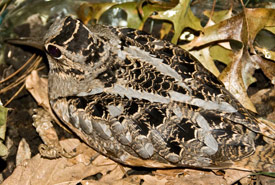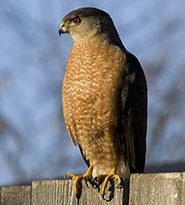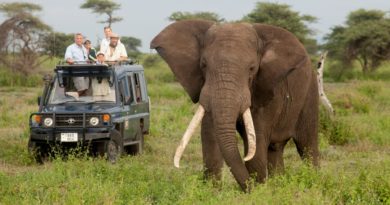Things that go bump in the field
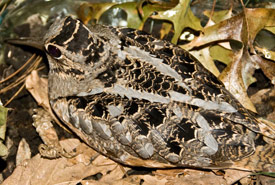
American woodcock (Photo by Lavandar Fields/Wikimedia Commons)
I have spent a lot of time at a lot of different field sites over the years. I have spent days in the blistering sun, days in the frigid cold and days in the pouring rain, but until last spring, I had never spent any time in the field after dark.
Every year, there is one field site with several kilometres of fencing that needs monitoring to ensure the fence is in good working order. This work can take many more hours than we expect and is often completed in very early spring, so the days are still quite short.
Last year, after a few days of repairing broken wires, straightening crooked poles and pulling tree branches out of the way, my field assistant and I were almost finished. It was nearing dusk and with a 1.5-kilometre walk back to the road, we knew we had to leave shortly to make it out before dark. But we were so, so close to being done.
“Let’s just go for it,” we thought. We fixed the final panel of fencing and we started the trek back to the road where our vehicles were parked. But when I said it was “nearing dusk,” I really meant that it was already dusk, so by the time we were on our way out, the sun had fully set and it was, well, total darkness. I have particularly bad night vision, so walking over ground full of hummocks, rocks and small shrubs was particularly challenging for me. Given the terrain, a quick pace was far from possible, so I just trudged steadily along in the dark.
It was quiet. It was so very quiet. Since it was spring, birds were starting to migrate back to their Ontario breeding grounds, so the quiet skies were slowly beginning to come to life again during the day, but night was a different experience. There was only our heavy breaths and the slight rustle of leaves in the trees above to break the silence.
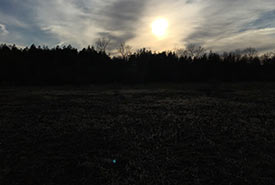
The only photo that I got before the sun disappeared (Photo by NCC)
Suddenly, the quiet was interrupted by a very quick, almost vibration-like sound…and whatever made it was right behind us. Before we could even turn around, we heard a forceful “peeeent” from that same direction. My field assistant and I spun around, but halfway through our rotation, we heard the same vibrating sound again and it was gone.
We took a few more steps and then heard the same quick vibration sound followed by a loud “peeeent.” After this happened consistently for another two minutes, I knew I needed to figure out what was making this sound. The vibrating sound was definitely the wind rushing through feathers, so we knew it was a bird, but this was still very early in my birding career (I still knew almost nothing about birds), so that was about it. Something about the sound was oddly recognizable to me, but I just couldn’t place it. So, we walked slowly a few metres away and then turned around quietly and waited. As if perfectly on cue, the vibrating sound was back and as soon as it settled, I shone the light of my phone camera in front of us. And as soon as I caught sight of the bird, I knew exactly what it was, having watched this hilarious internet sensation many times. It was a woodcock!
As soon as I got a glimpse, it was off again, and we continued to walk back to the road. The whole way back, the woodcock followed us, “peent-ing” the entire time. Maybe we were bothering it and it was trying to get rid of us? Maybe it was protecting something? Or maybe it was just genuinely curious about what we were doing in its home territory so late in the day. Either way, when it escorted us to the car, it gave me a feeling of safety — like something was watching out for us in the darkness.
As we reached the vehicle and packed up our tools and equipment, I heard another nighttime sound, more immediately recognizable: the familiar call of the whip-poor-will was bouncing around in the distance.
Having never spent any time in the field at night before, that night was a very memorable experience for me. And it was certainly an excellent reminder that when you’re doing field work or spending time in nature, no matter what time it is, you are never truly alone.
This post originally appeared on the Dispatches from the Field blog and is reposted with permission.

